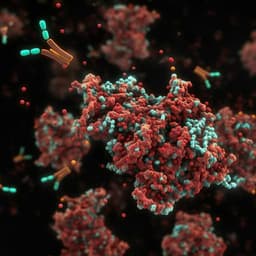
Medicine and Health
MYC targeting by OMO-103 in solid tumors: a phase 1 trial
E. Garralda, M. Beaulieu, et al.
This phase 1 study explores the safety and tolerability of OMO-103, a MYC inhibitor, in patients with advanced solid tumors. The findings revealed promising insights, with several patients maintaining stable disease after treatment. This research was conducted by a team of experts including Elena Garralda and Marie-Eve Beaulieu.
~3 min • Beginner • English
Introduction
MYC is frequently deregulated across human cancers and orchestrates transcriptional programs governing proliferation, metabolism, survival, and immune suppression. Despite its attractiveness as a target, MYC has been considered undruggable due to its intrinsically disordered structure. Omomyc, a dominant-negative MYC variant, disrupts MYC–MAX dimerization and DNA binding, shutting down MYC-driven transcription. The purified Omomyc miniprotein (OMO-103) shows cell-penetrating activity and preclinical efficacy in multiple tumor models. This first-in-human phase 1 study was designed to evaluate the safety, tolerability, PK, and preliminary antitumor activity of OMO-103 in patients with advanced solid tumors, establish a recommended phase 2 dose, and assess target engagement and exploratory biomarkers.
Literature Review
Preclinical studies established Omomyc as a robust MYC inhibitor capable of impairing tumor initiation and maintenance across diverse models, independent of MYC expression levels. Omomyc blocks MYC–MAX binding to E-box sequences, forming inactive dimers that prevent transcription of MYC targets. Purified Omomyc demonstrated in vivo efficacy and safety via intranasal or intravenous routes in non-small cell lung cancer and triple-negative breast cancer models, including effects on tumor microenvironment reprogramming and synergy with chemotherapy. Prior pharmacokinetic analyses in tumors indicated lasting structural integrity and prolonged tissue half-life. Given MYC’s roles in therapy resistance and immune evasion, inhibiting MYC may overcome resistance mechanisms and restore antitumor immunity.
Methodology
Design and population: MYCure (NCT04808362) was a first-in-human, open-label, multicenter phase 1 dose-escalation trial conducted at three sites in Spain. Adults with histologically/cytologically confirmed advanced solid tumors lacking curative options and progressing on, intolerant to, or without standard of care were eligible. Key criteria included measurable disease (RECIST v1.1), ECOG 0–1, life expectancy ≥12 weeks, and adequate organ function. MYC amplification/overexpression was not required. Twenty-two patients were enrolled (median age 60.5 years; balanced sex; median 4 prior lines, range 2–12) with varied tumor types (notably PDAC and CRC).
Intervention and escalation: OMO-103 was administered as weekly 30–45 min IV infusions in 21-day cycles. Dose levels were 0.48, 1.44, 2.88, 4.32, 6.48, and 9.72 mg/kg (n=1,1,3,5,9,3). An accelerated titration was followed by a 3+3 design. Treatment continued until progression or unacceptable toxicity. Safety follow-up was 1 month. Intrapatient escalation was allowed when higher dose levels were deemed safe.
Outcomes: Primary: safety and tolerability. Secondary: RP2D, PK, pharmacodynamics (PD), preliminary antitumor activity, and biomarkers.
Safety assessments: AEs were graded per NCI-CTCAE v5.0. DLTs were grade ≥3 adverse events at least possibly related to OMO-103 within the first 21 days. MTD was defined by standard 3+3 rules.
Efficacy assessments: CT scans were performed at baseline, week 9 (after 3 cycles), and q9 weeks thereafter, per RECIST v1.1. Total volumetric analyses complemented RECIST for exploratory assessment. Circulating tumor DNA was analyzed with Guardant360 (73-gene panel) at baseline and on-treatment timepoints.
PK and immunogenicity: Serial serum sampling around infusions at cycles 1, 3, 6, and 9 up to 96 h post-infusion assessed OMO-103 concentrations by validated ECLA; noncompartmental analysis derived parameters (t1/2, AUC, CL, Vz). Anti-drug antibodies (ADAs) were assessed at screening, early cycles, every three cycles, end of treatment, and 1-month follow-up by validated ECLA bridging assay.
Tumor biopsies and biomarker analyses: Mandatory paired pre- and on-treatment biopsies (after ≥3 infusions; around C1D15–19) were obtained when feasible. OMO-103 levels in FFPE tissue were quantified by mass spectrometry using multiple Omomyc peptides. Digital spatial profiling (DSP) RNA analysis (GeoMx Human Whole Transcriptome Atlas) was performed on selected regions (PANCK+ tumor and PANCK− microenvironment), with GSEA against established MYC gene sets and immune/cancer pathways. Ultradeep DIA proteomics assessed protein-level modulation of MYC targets in paired samples.
Soluble factors: Serum cytokines/chemokines (GM-CSF, IFNα, IFNγ, IL-1α, IL-1β, IL-4, IL-6, IL-8, IL-10, IL-12p70, IL-13, IL-17A, TNFα, IP-10, MCP-1, MIP-1α, MIP-1β, ICAM-1, CD62E, CD62P) were measured longitudinally by Luminex. Predictive (baseline) and pharmacodynamic (on-treatment) signatures were explored using univariate statistics, logistic regression, ROC-AUC, and QLattice modeling with leave-one-out cross-validation.
Key Findings
Safety and tolerability: No MTD was reached. The most common treatment-related adverse events were low-grade infusion-related reactions (IRRs: chills, fever, nausea, rash, hypotension). Ten of 22 patients experienced IRRs; 6 had a single episode, 4 had multiple episodes. Most IRRs occurred after the first infusion, 2–5 h post-infusion, resolving within hours to overnight. Overall, 58/72 treatment-related AEs were grade 1 (80.5%), 12/72 grade 2 (16.6%), and 1/72 grade 3 (1.4%). One grade 3 IRR (ovarian carcinoma) was deemed patient-dependent and not dose-related. One DLT (grade 2 pancreatitis) occurred at DL5 in a PDAC patient; the patient recovered fully. Eighteen serious AEs occurred overall; only one (the grade 3 IRR) was considered drug-related. Two deaths due to disease progression (PDAC) occurred. RP2D was set at DL5 (6.48 mg/kg) based on safety, PK, tissue saturation, preliminary activity, and biomarker data.
PK and tissue exposure: PK was nonlinear above DL5, with disproportionate AUC increases and decreased clearance/volume after multiple dosing, indicating tissue saturation. Estimated terminal serum half-life was ~40 h (likely underestimated given sampling to 96 h). Mass spectrometry detected intact OMO-103 in tumor tissue up to 19 days after the last infusion. No ADAs were detected across patients and timepoints, except a transient positive in one DL5 patient with elevated rheumatoid factor, a known assay confounder.
Antitumor activity: Of 22 patients, 19 were evaluable for efficacy. Twelve reached the prespecified 9-week CT assessment; 8 achieved stable disease (across DL2–DL6) with durations from 35 to 765 days, including PDAC (n=2), CRC (n=3), NSCLC (n=1), fusocellular sarcoma (n=1), and salivary gland carcinoma (n=1). One PDAC patient at DL3 had 8% RECIST target shrinkage at first scan, an 83% ctDNA reduction by week 11, and a best 49% reduction in total tumor volume. A salivary gland carcinoma patient remained stable for ~26 months under compassionate use. No objective responses by RECIST were recorded. No correlation was observed between MYC IHC H-score and clinical response.
Target engagement and biology: DSP transcriptomics of paired biopsies (n=6 patients across DL3 and DL5) showed shutdown of multiple MYC transcriptional signatures post-treatment, more frequently at DL5 and in patients with stable disease compared to progressive disease. Immune-related gene sets, especially T cell-mediated immunity, were upregulated after treatment, and MYC signature suppression was observed in both tumor (PANCK+) and microenvironment (PANCK−) compartments. Proteomics of paired biopsies indicated broader downregulation of MYC Hallmark and direct targets in stable disease versus progressive disease.
Biomarkers: Baseline serum levels of MIP-1β, IL-8, CD62E, and GM-CSF were significantly lower in patients who achieved stable disease at cycle 3 versus progressive disease; univariate logistic models showed high ROC-AUCs (MIP-1β 0.97, IL-8 0.89, CD62E 0.87, GM-CSF 0.85). QLattice-derived combinations further improved prediction (AUCs 0.96–0.98). Pharmacodynamic analyses identified a transient on-treatment increase in IFNγ, CD62E, and IL-17A from cycle 3 onwards exclusively in patients who achieved stable disease (ROC-AUCs: IFNγ 0.96, CD62E 0.96, IL-17A 1.00), with the signature waning upon progression.
Discussion
This first-in-human study demonstrates that direct MYC inhibition with the miniprotein OMO-103 is clinically feasible and generally well tolerated, with mainly low-grade infusion-related reactions and no MTD identified. The selection of 6.48 mg/kg as RP2D was supported by safety, nonlinear PK consistent with tissue saturation, and prolonged tumor tissue exposure. Evidence of pharmacodynamic target engagement, including suppression of canonical MYC transcriptional programs in patient biopsies and downregulation of MYC targets at the protein level, supports the intended mechanism in humans. Although no RECIST objective responses were observed in this heavily pretreated cohort, disease stabilization in 8 of 19 evaluable patients, with notable volumetric tumor reduction and ctDNA declines in individual cases, indicates preliminary antitumor activity. The immunologic remodeling observed—upregulation of T cell–associated pathways and transient increases in IFNγ, CD62E, and IL-17A in patients with sustained stable disease—aligns with MYC’s known roles in immune suppression and suggests that MYC inhibition may potentiate antitumor immunity. The identification of baseline and on-treatment soluble factor signatures with high predictive performance, independent of tumor type, provides a foundation for patient selection and early response monitoring in future studies.
Conclusion
OMO-103, a first-in-modality MYC-inhibitory miniprotein, was safe and well tolerated across dose levels in advanced solid tumors, with RP2D established at 6.48 mg/kg weekly. Pharmacokinetics indicated tissue saturation at efficacious dose levels and durable tumor exposure. Preliminary clinical activity included sustained stable disease in multiple patients, supported by ctDNA and volumetric tumor reductions in selected cases. Robust molecular target engagement and immune activation signatures were demonstrated in patient biopsies, and soluble biomarkers with predictive and pharmacodynamic utility were defined. These results warrant further clinical evaluation of OMO-103, including in combination with chemotherapy, targeted therapies, and immunotherapies, and prospective validation of biomarker signatures for patient selection. Ongoing and future trials (e.g., NCT06059001) will assess combinations and refine predictive models.
Limitations
This phase 1 study enrolled a small, heterogeneous, heavily pretreated population without selecting for MYC amplification or overexpression, which may limit detection of maximal efficacy signals and generalizability. The number of paired biopsies available for transcriptomic and proteomic analyses was limited, reducing statistical power. Biomarker findings, though encouraging with high ROC-AUCs, require validation in larger, more homogeneous cohorts. Objective responses by RECIST were not observed, and relationships between MYC expression levels and sensitivity to OMO-103 in earlier treatment lines remain to be clarified.
Related Publications
Explore these studies to deepen your understanding of the subject.







